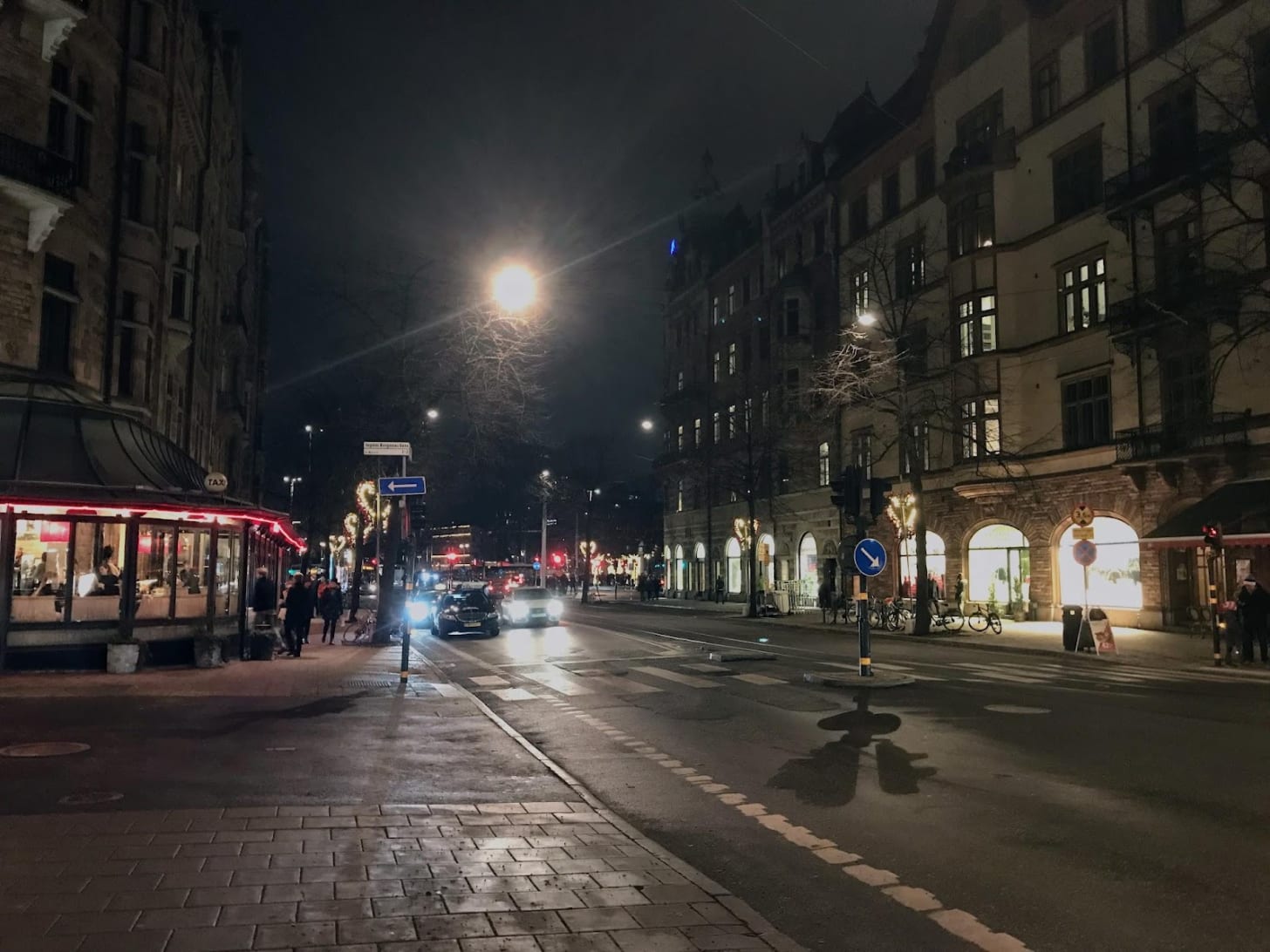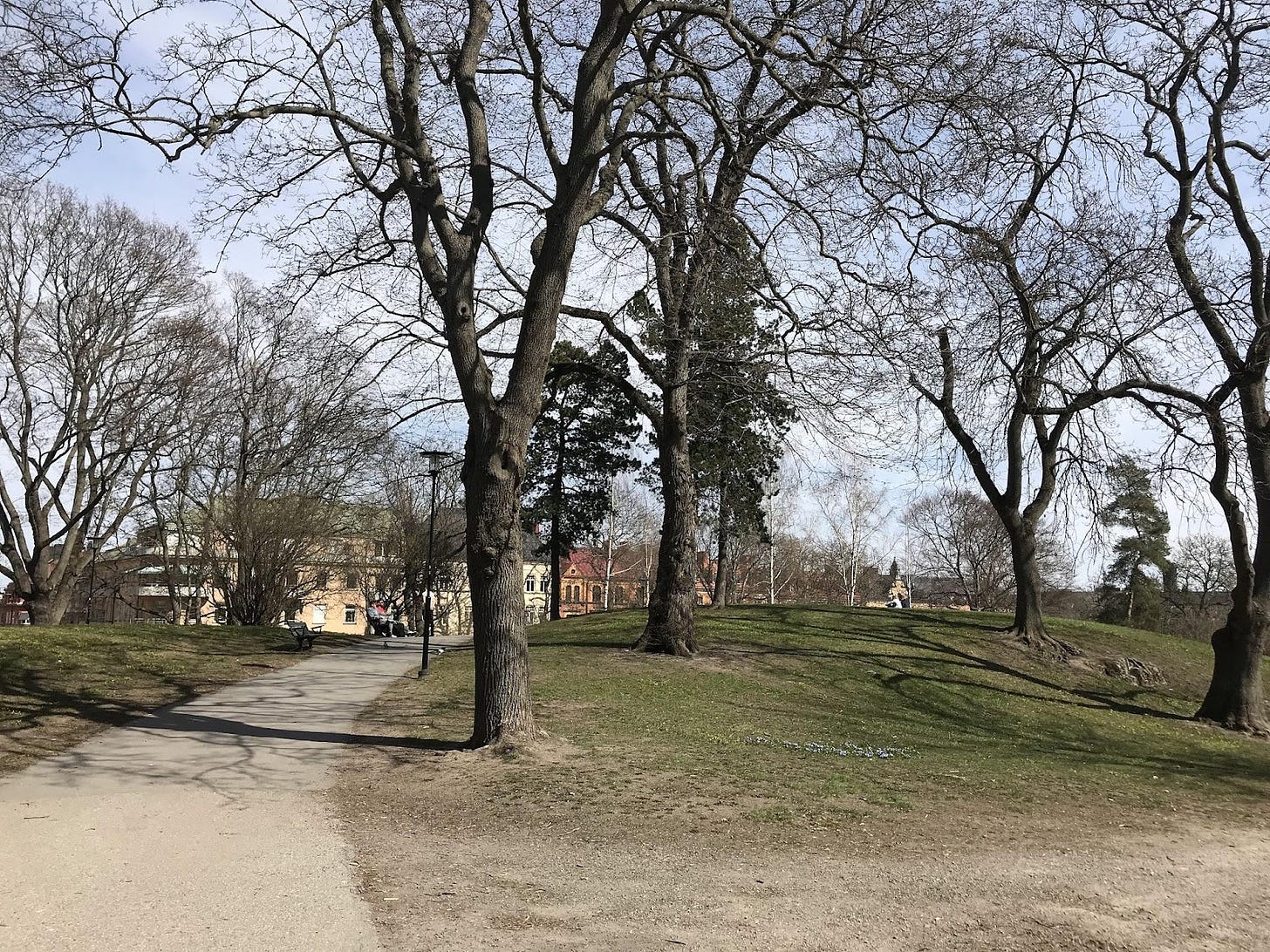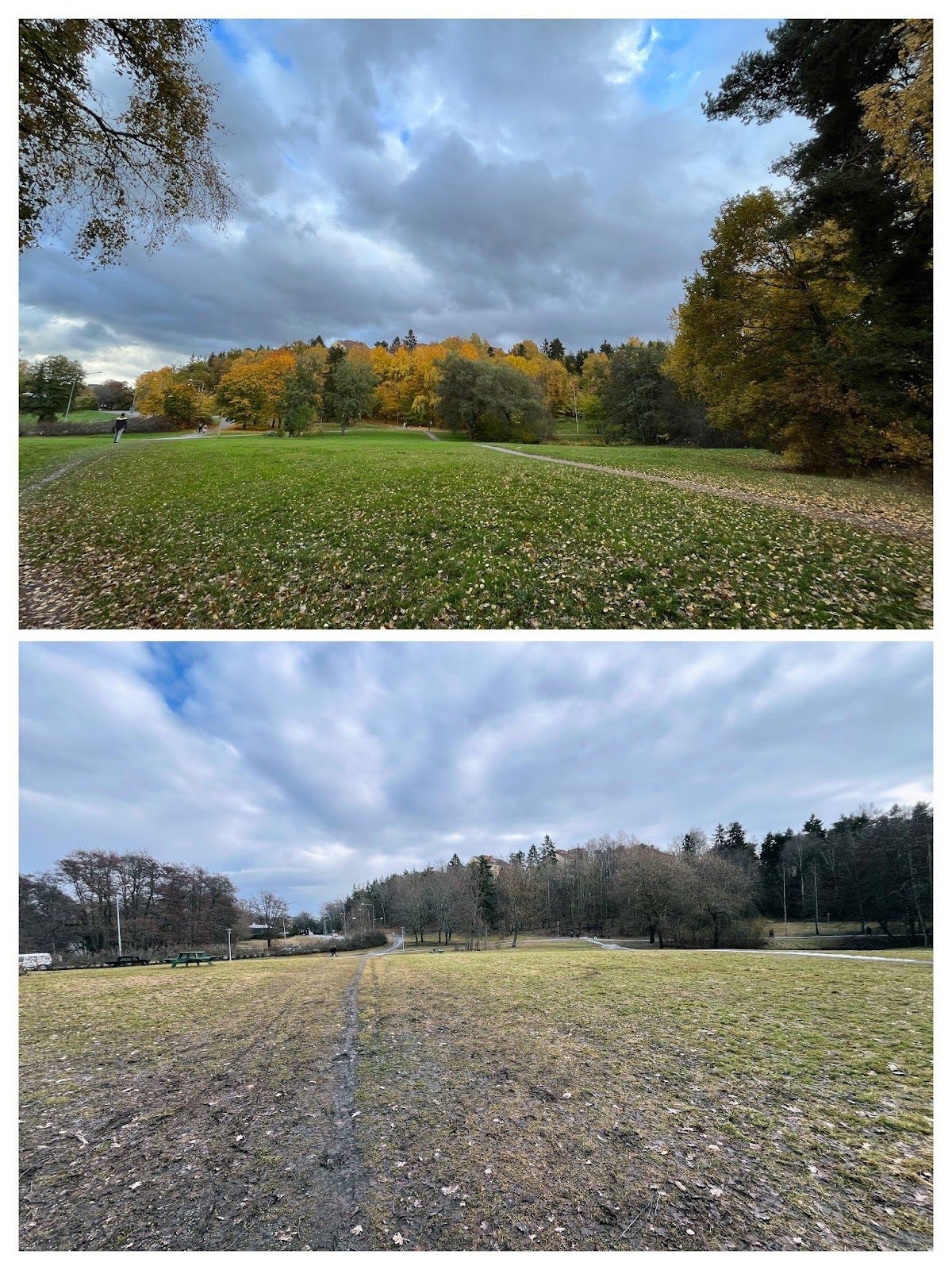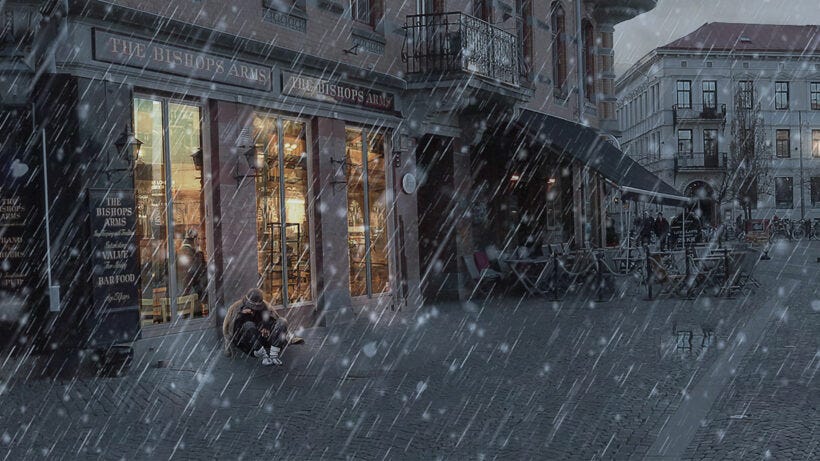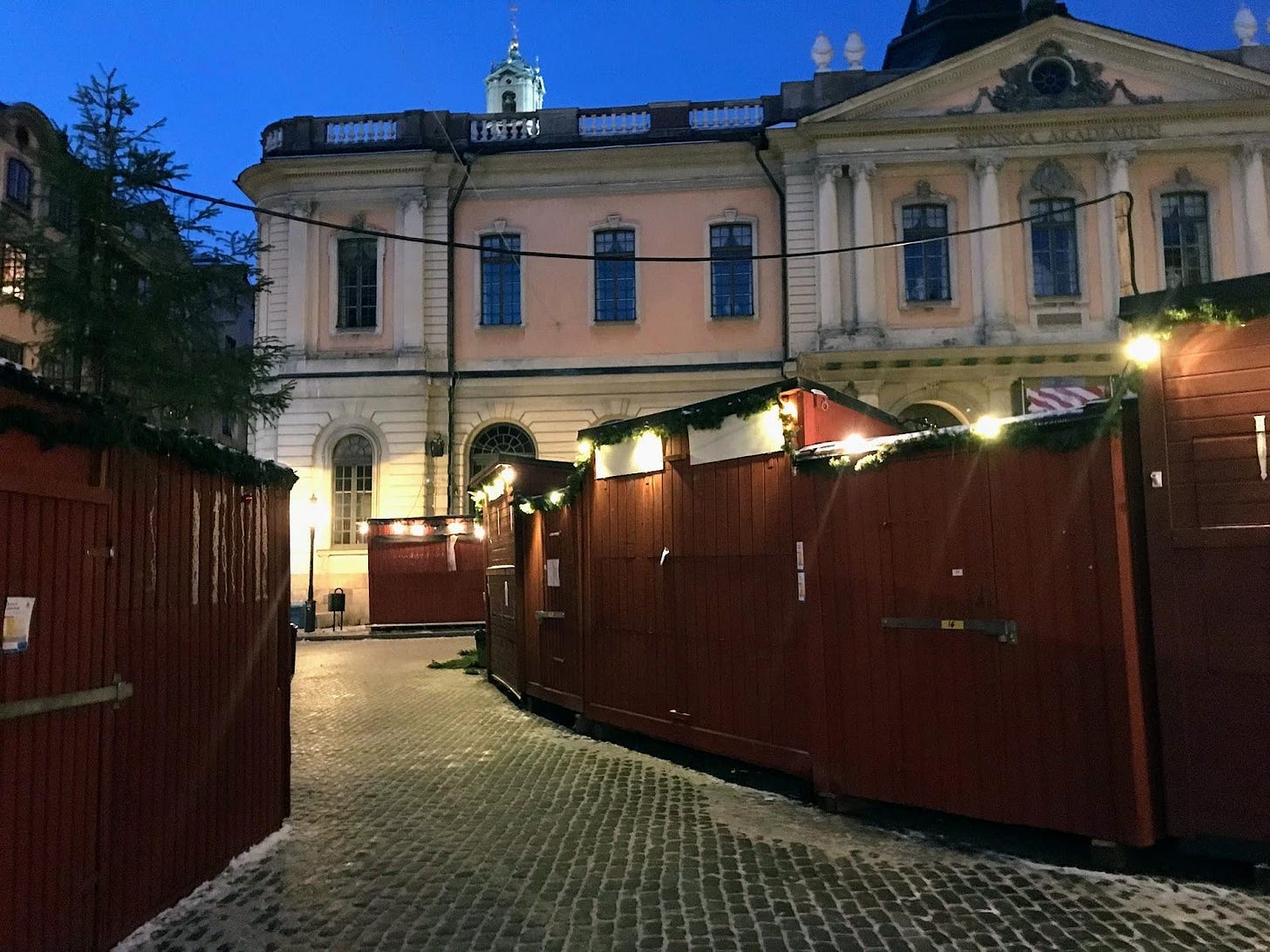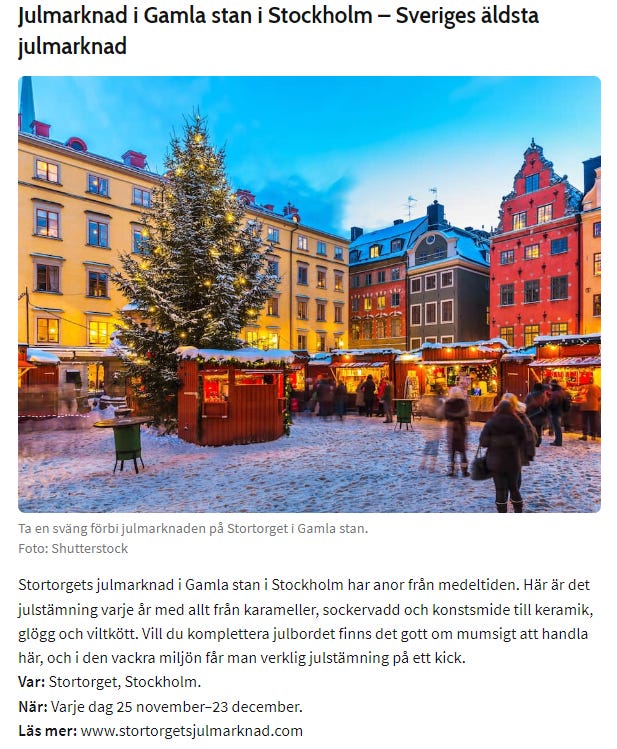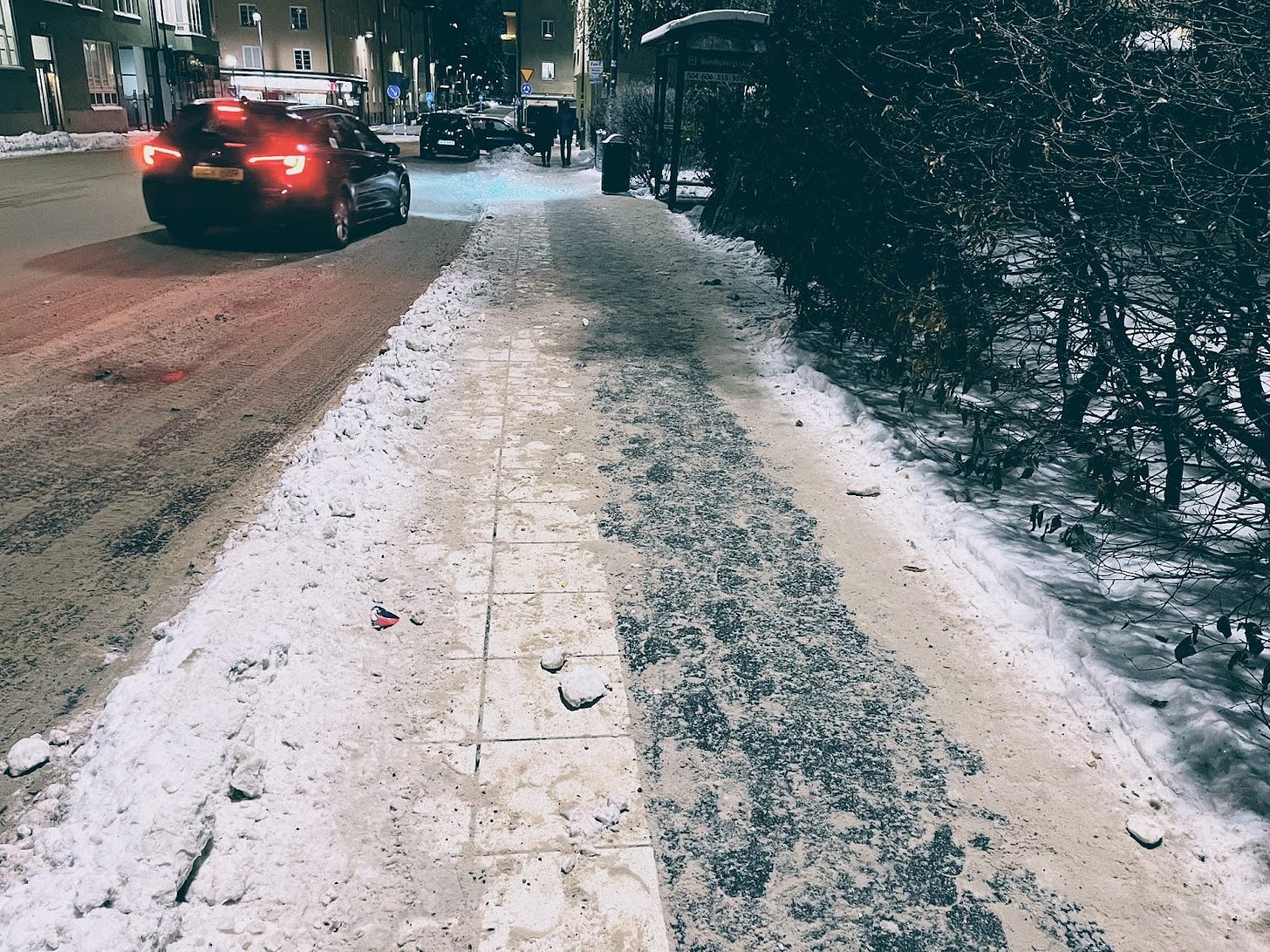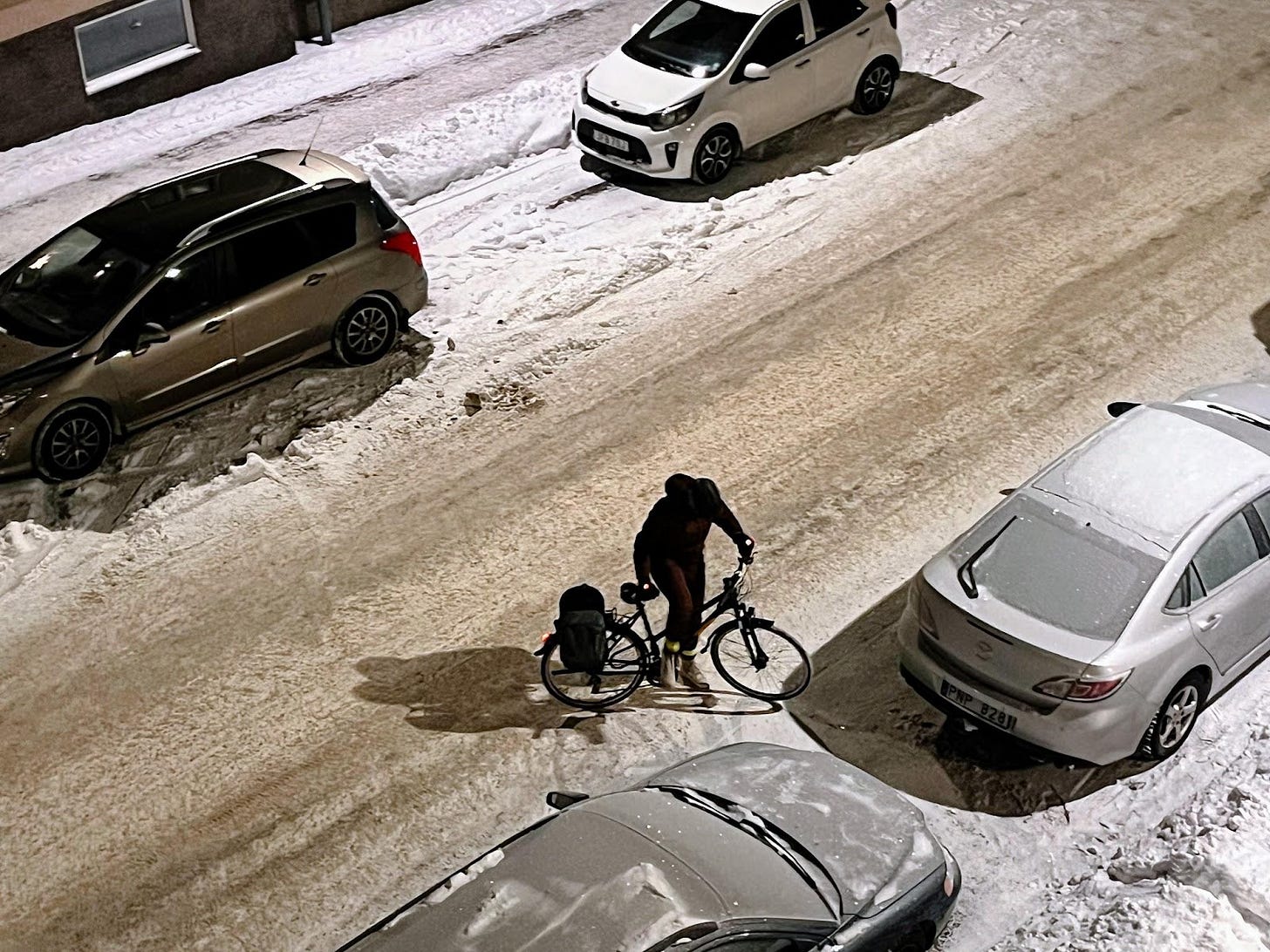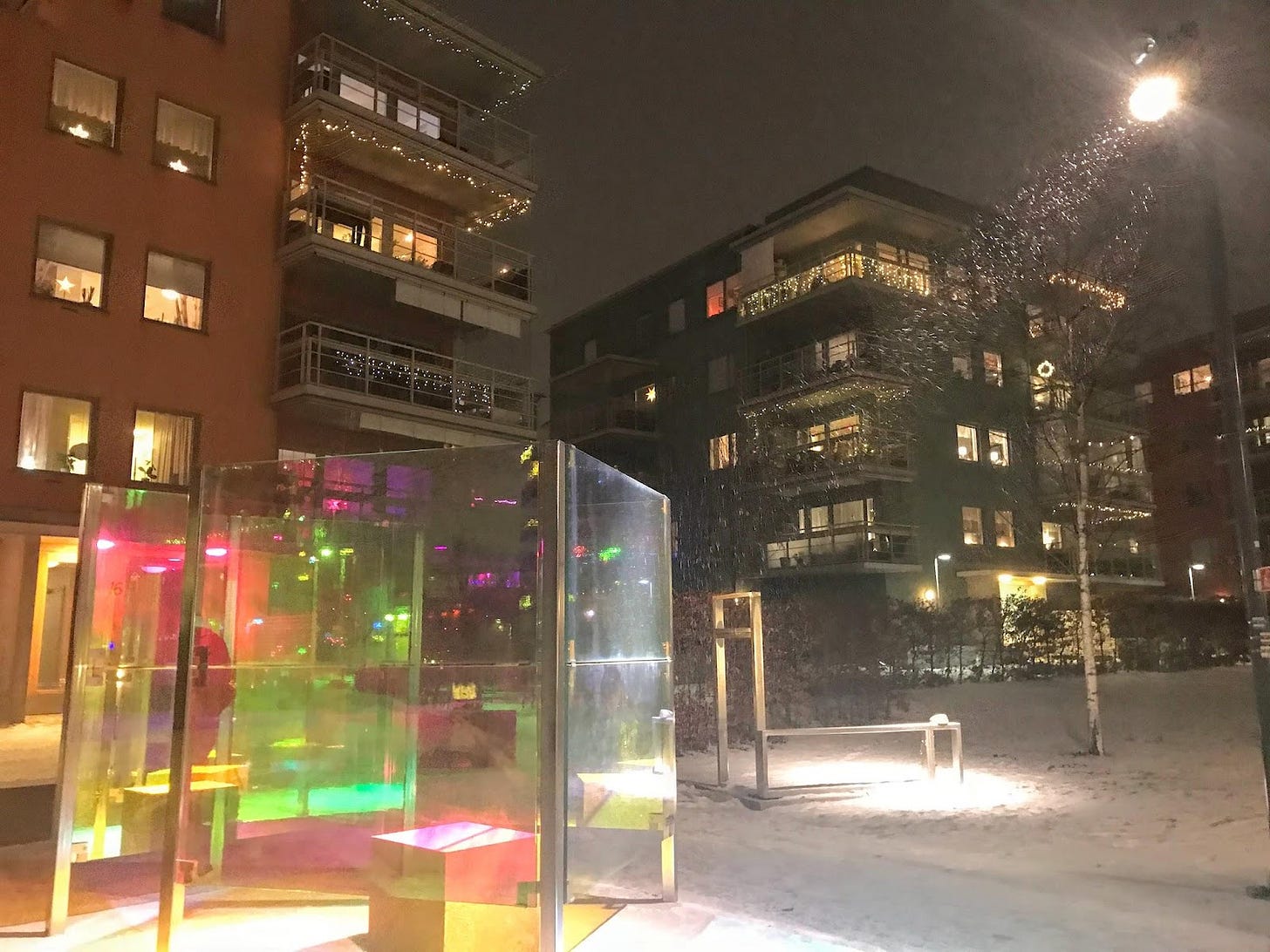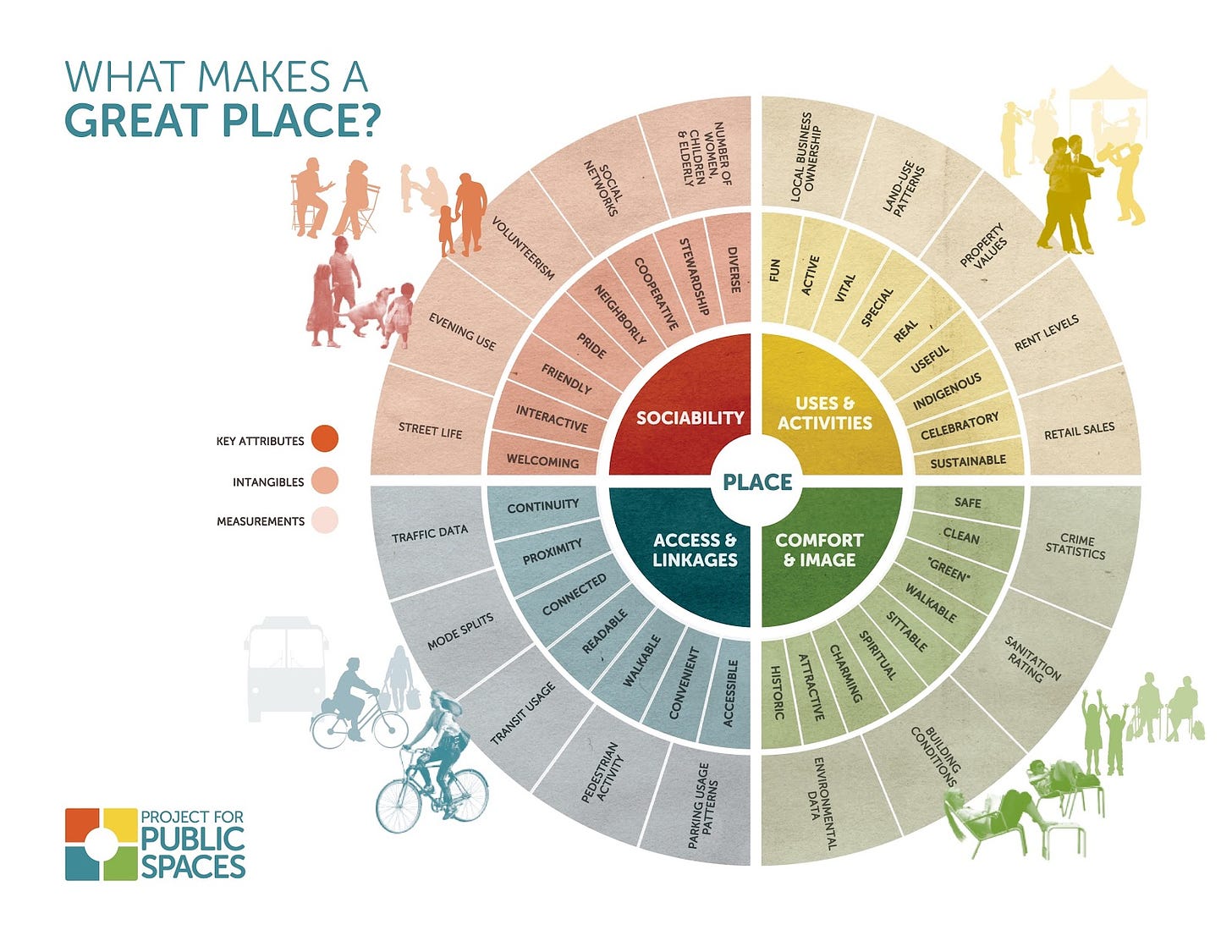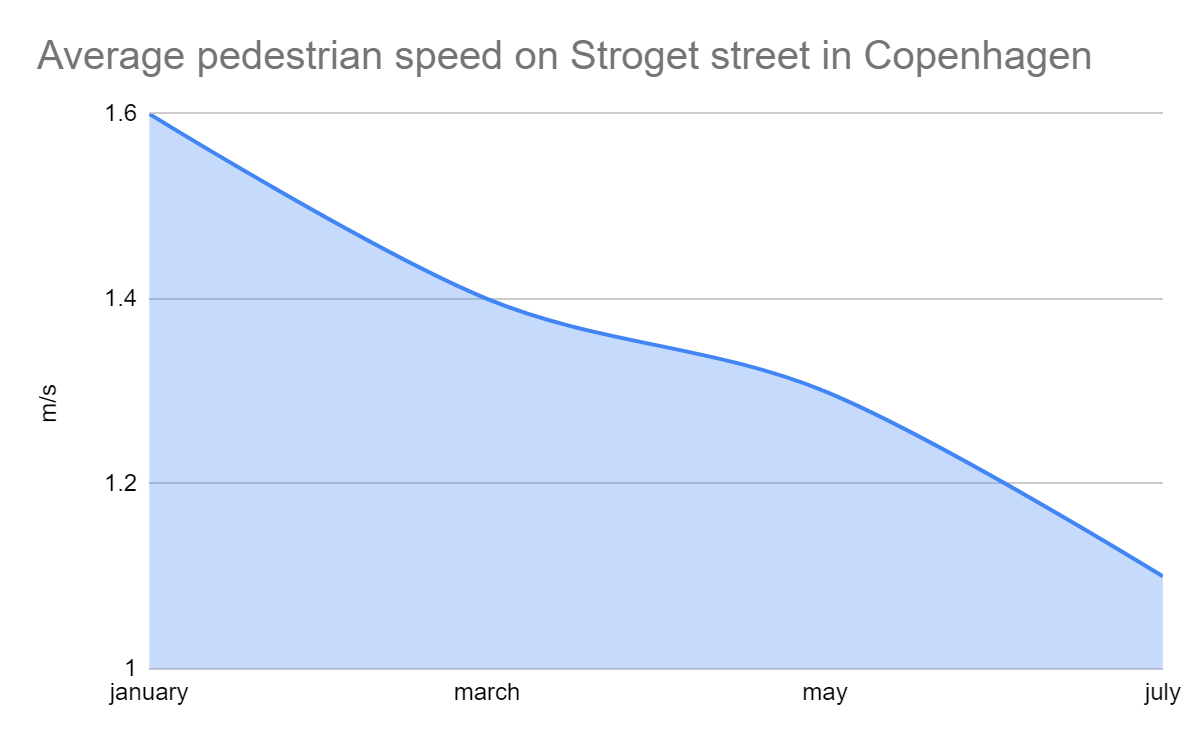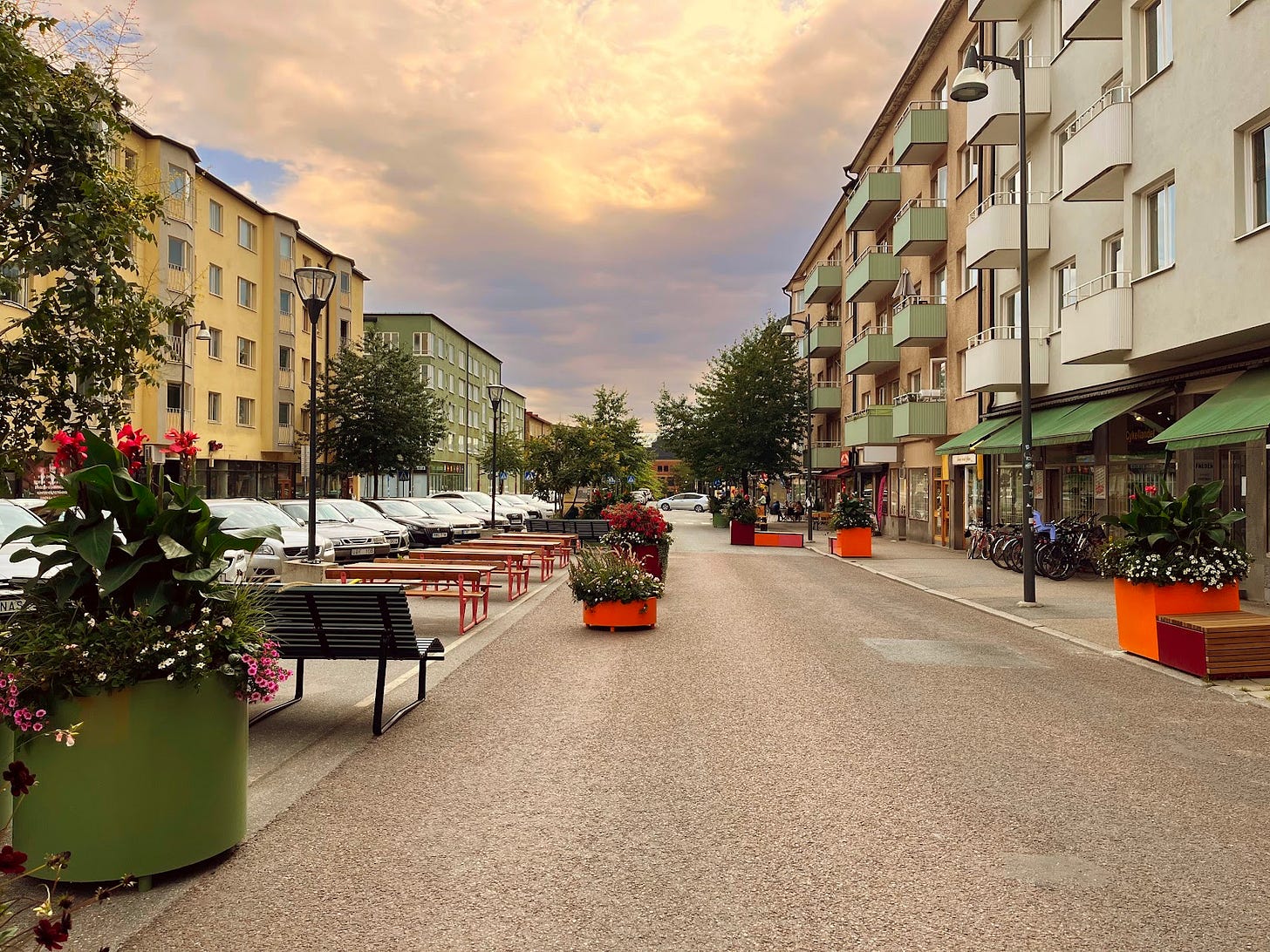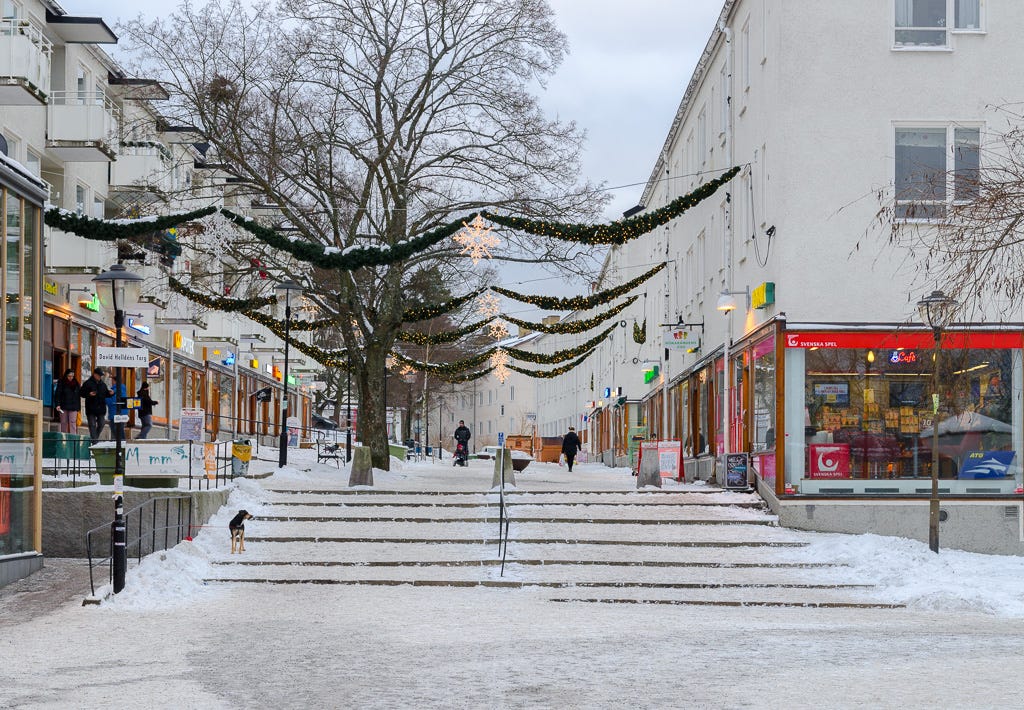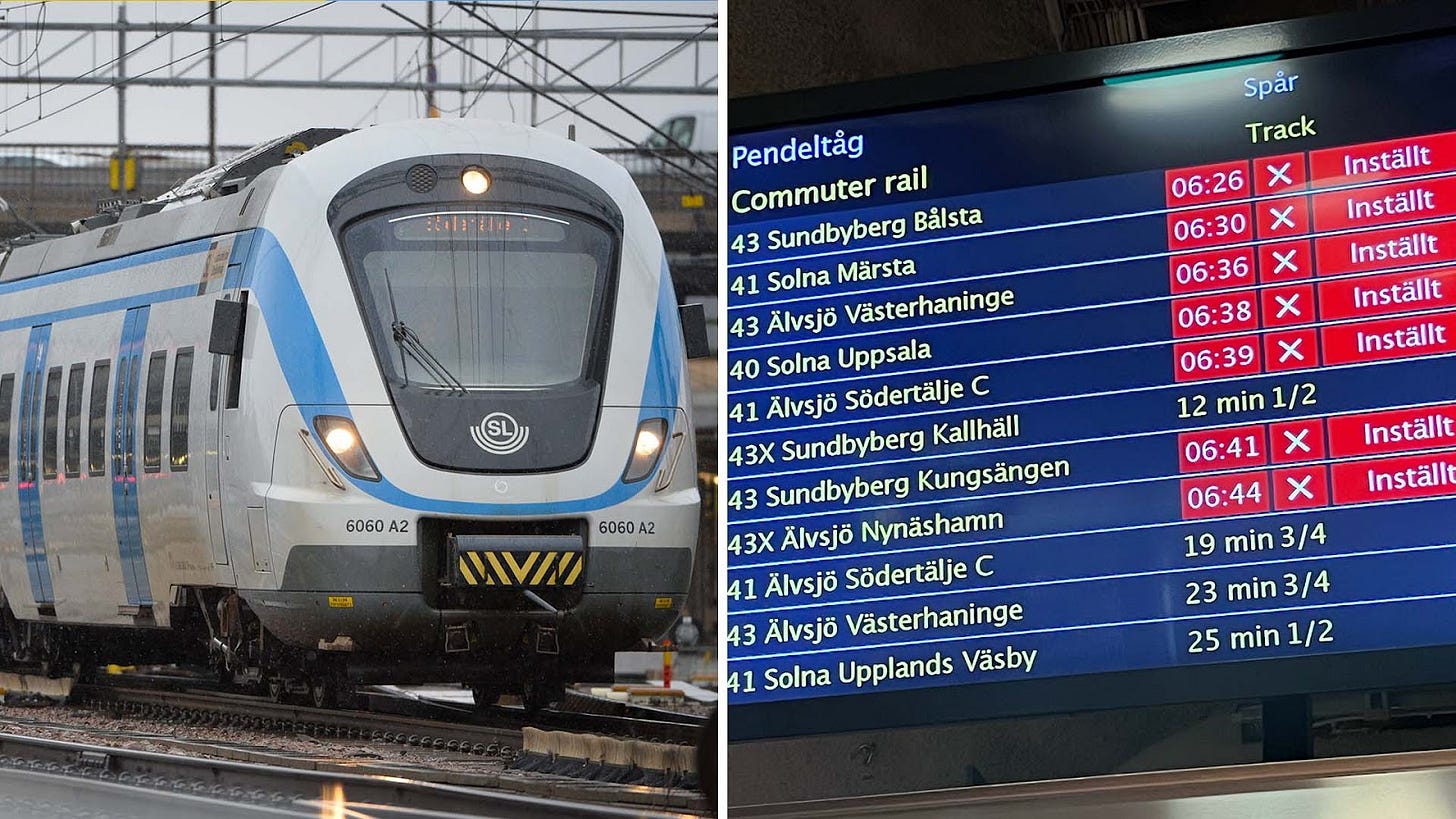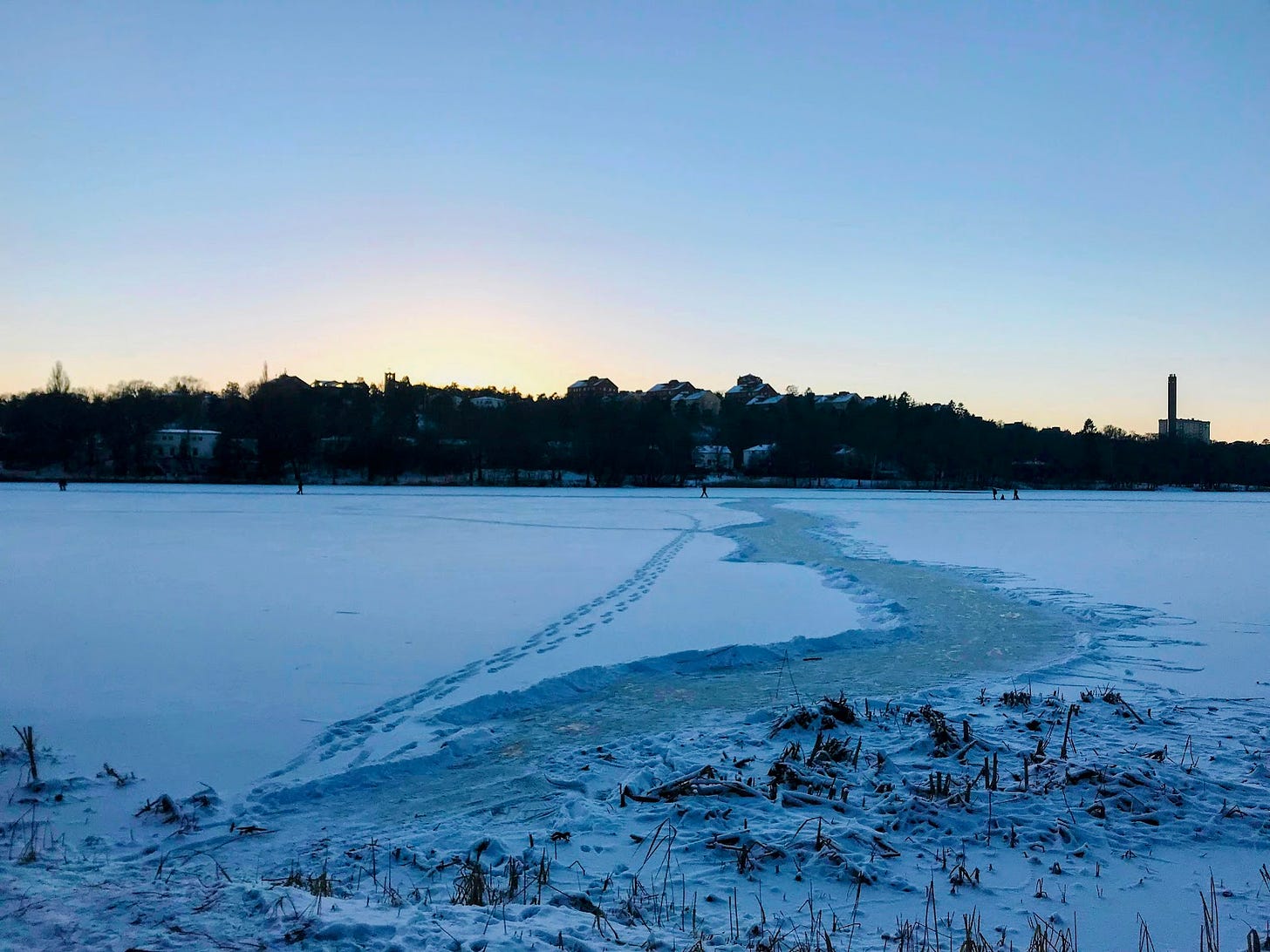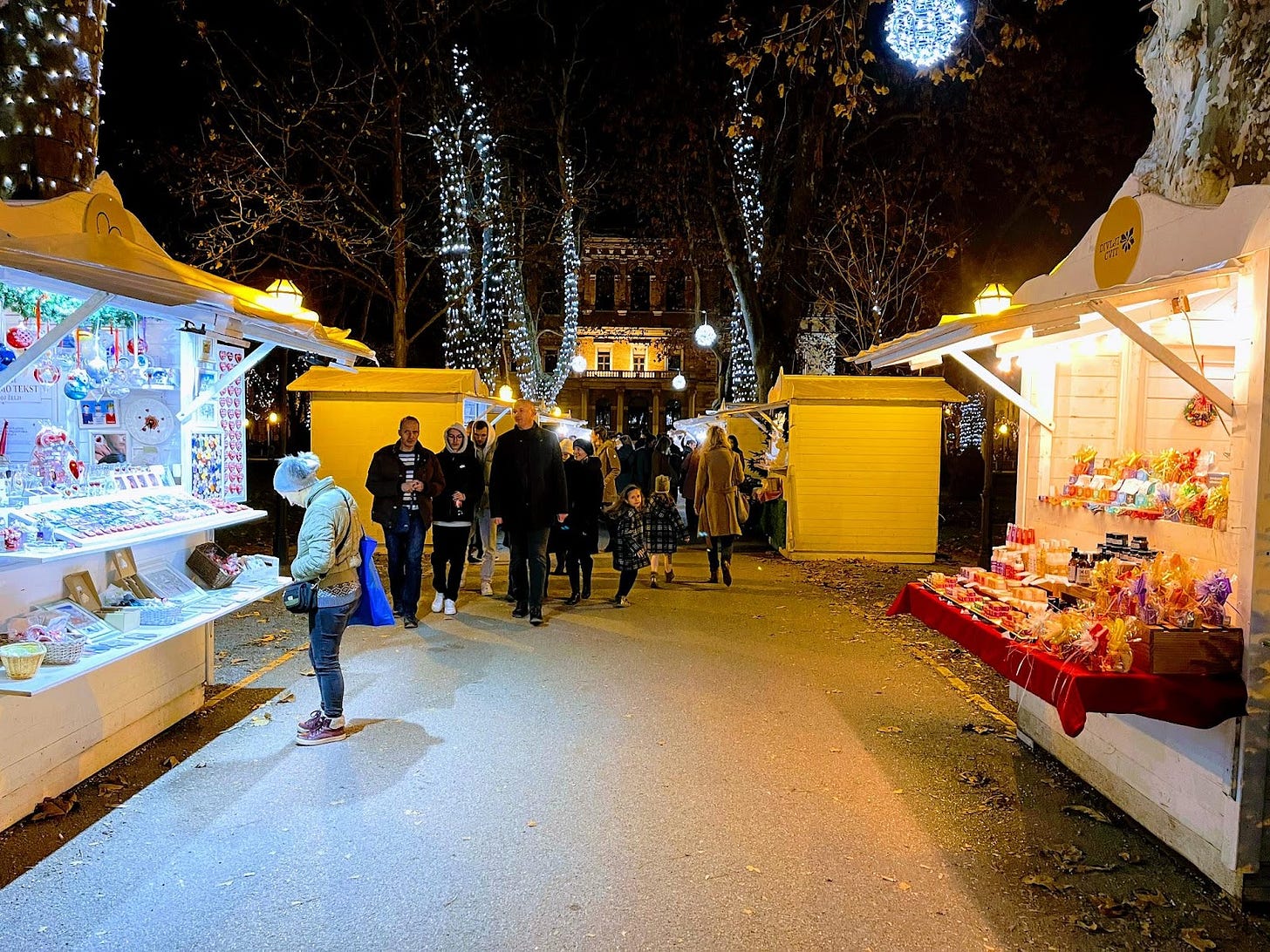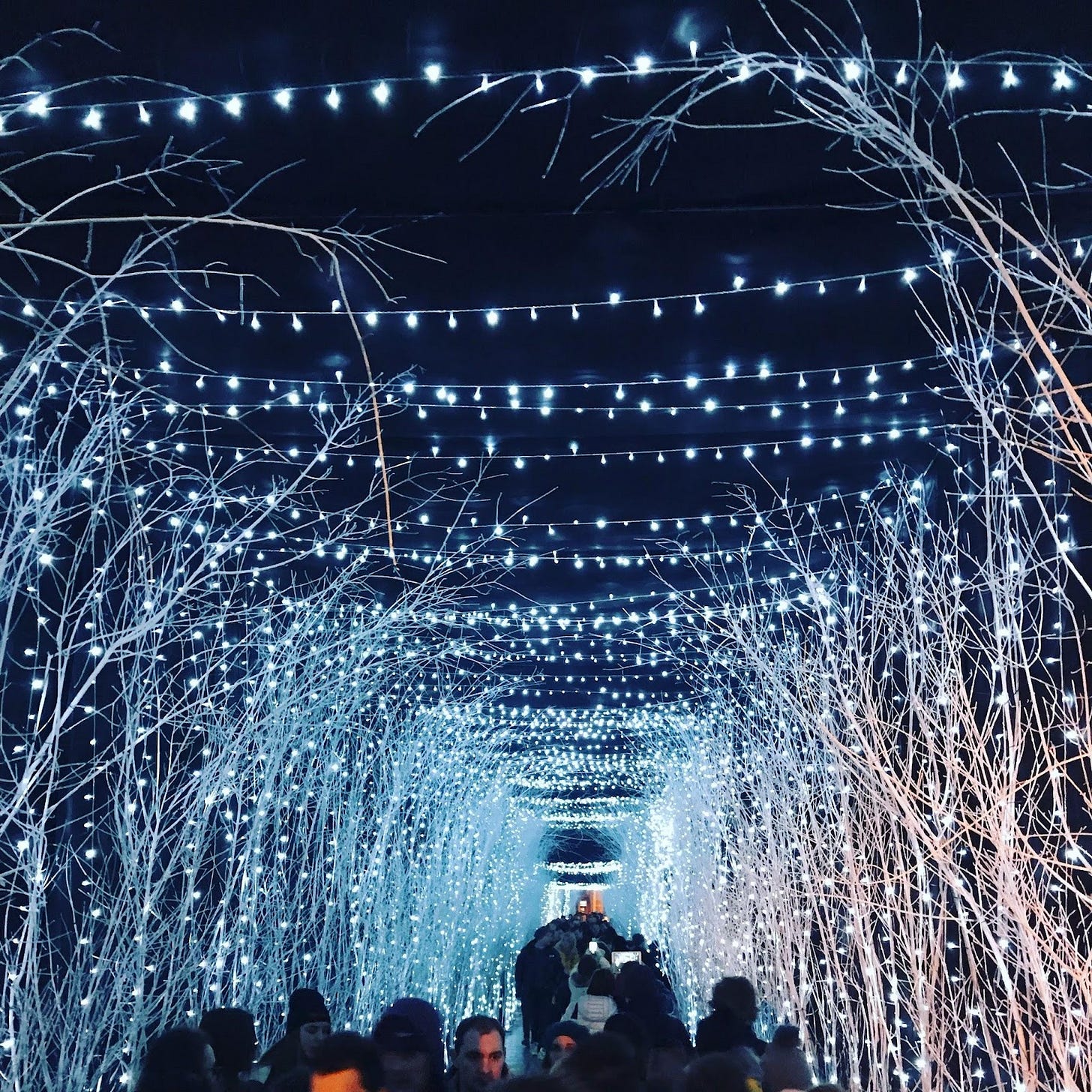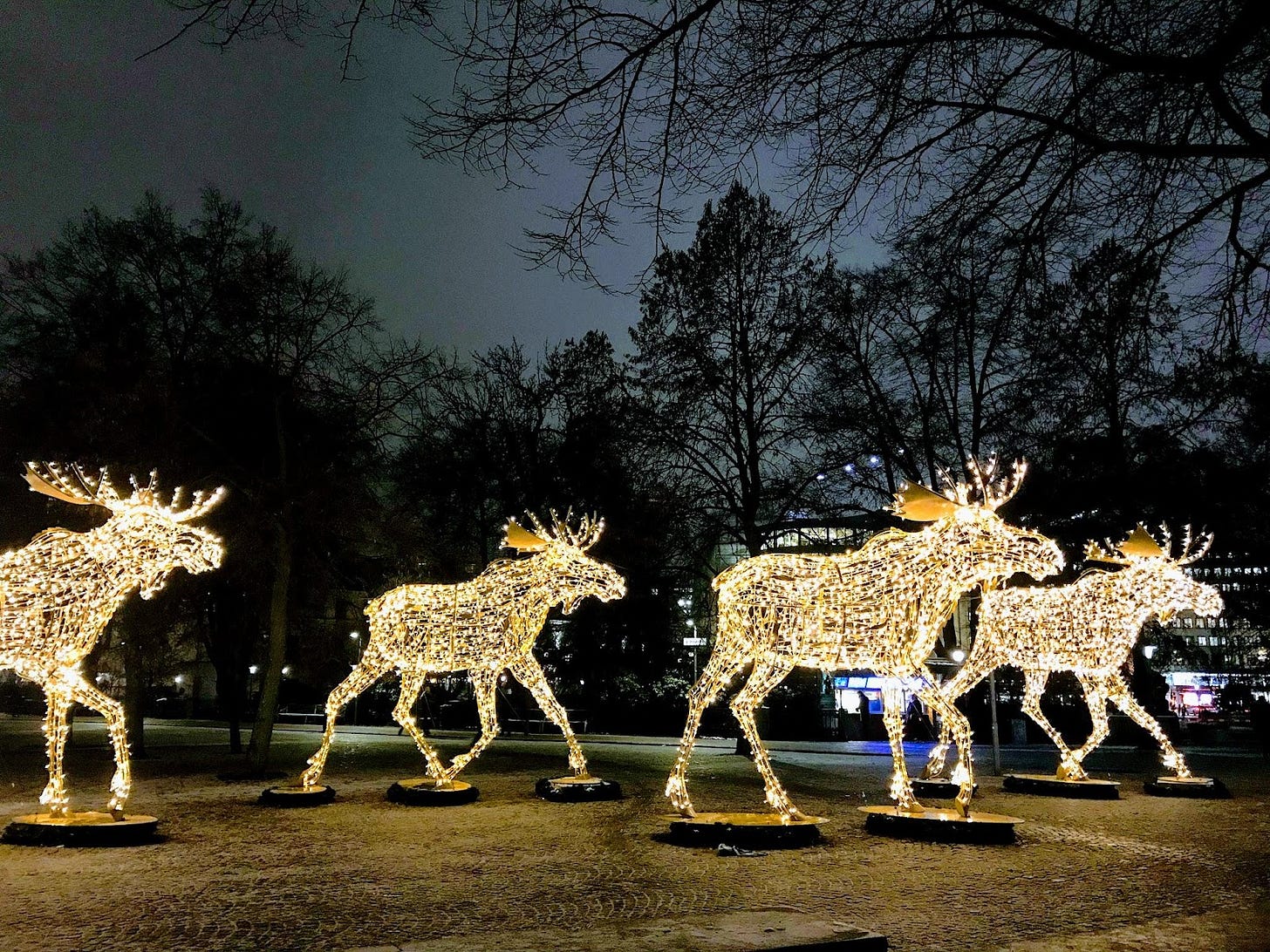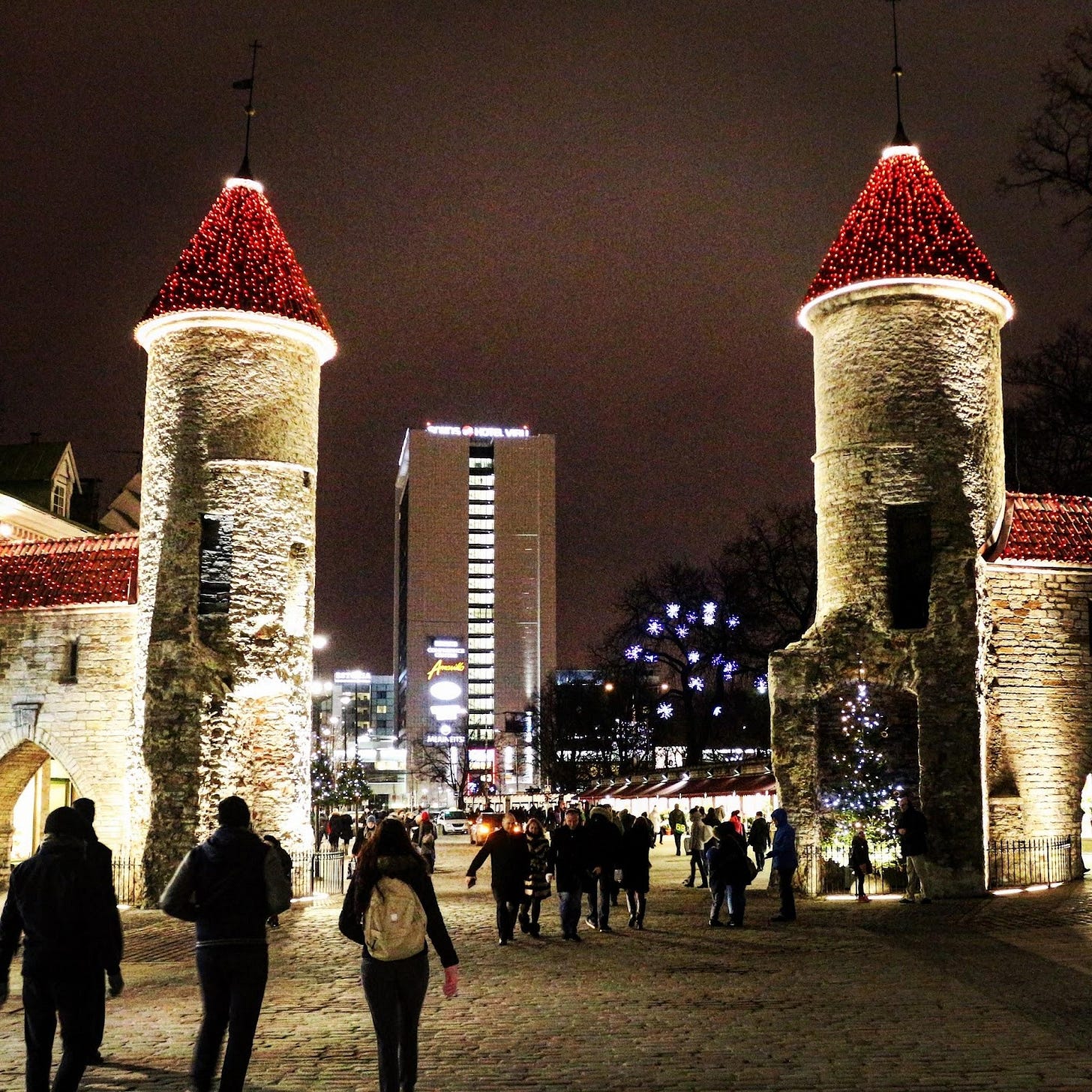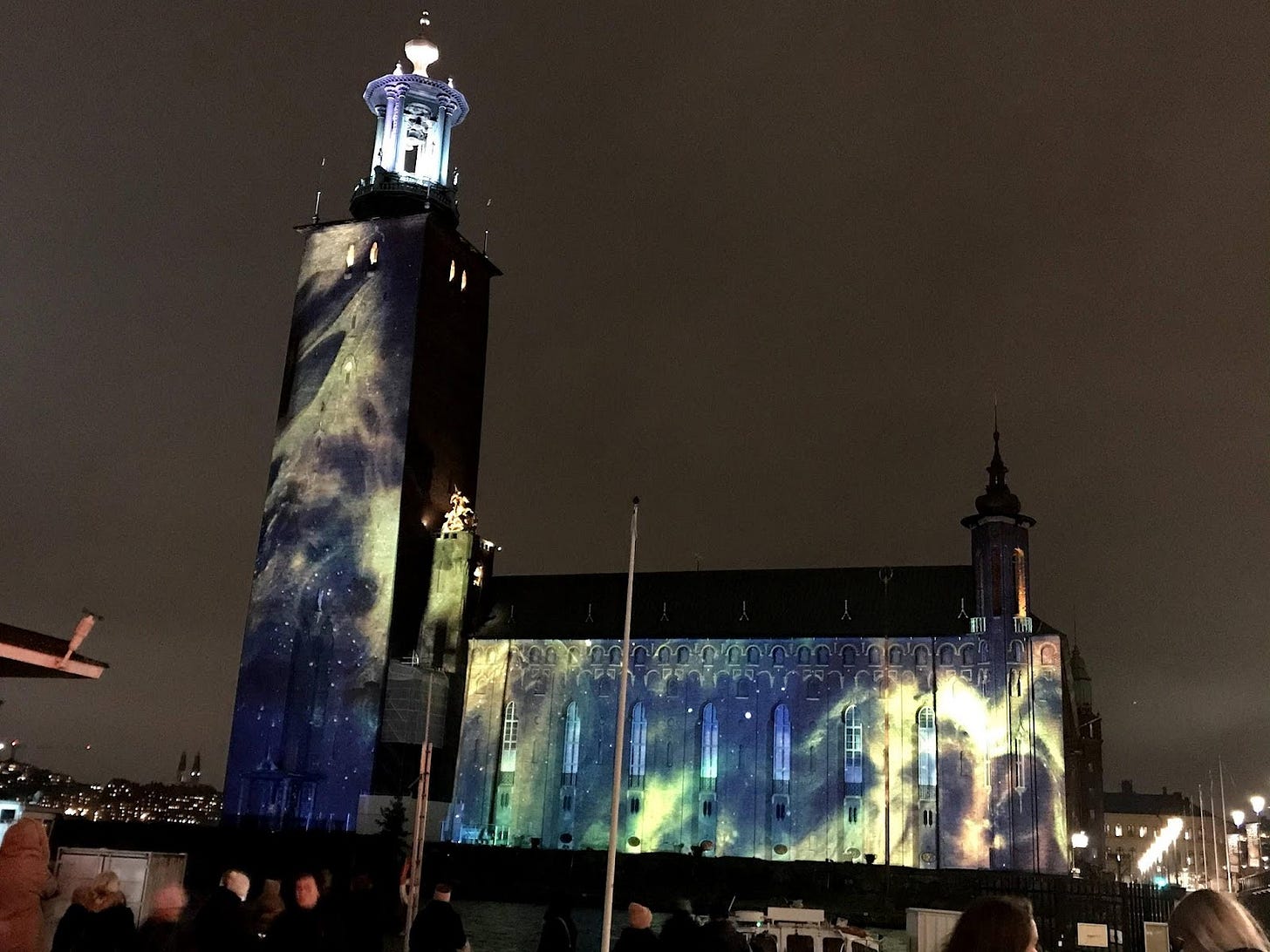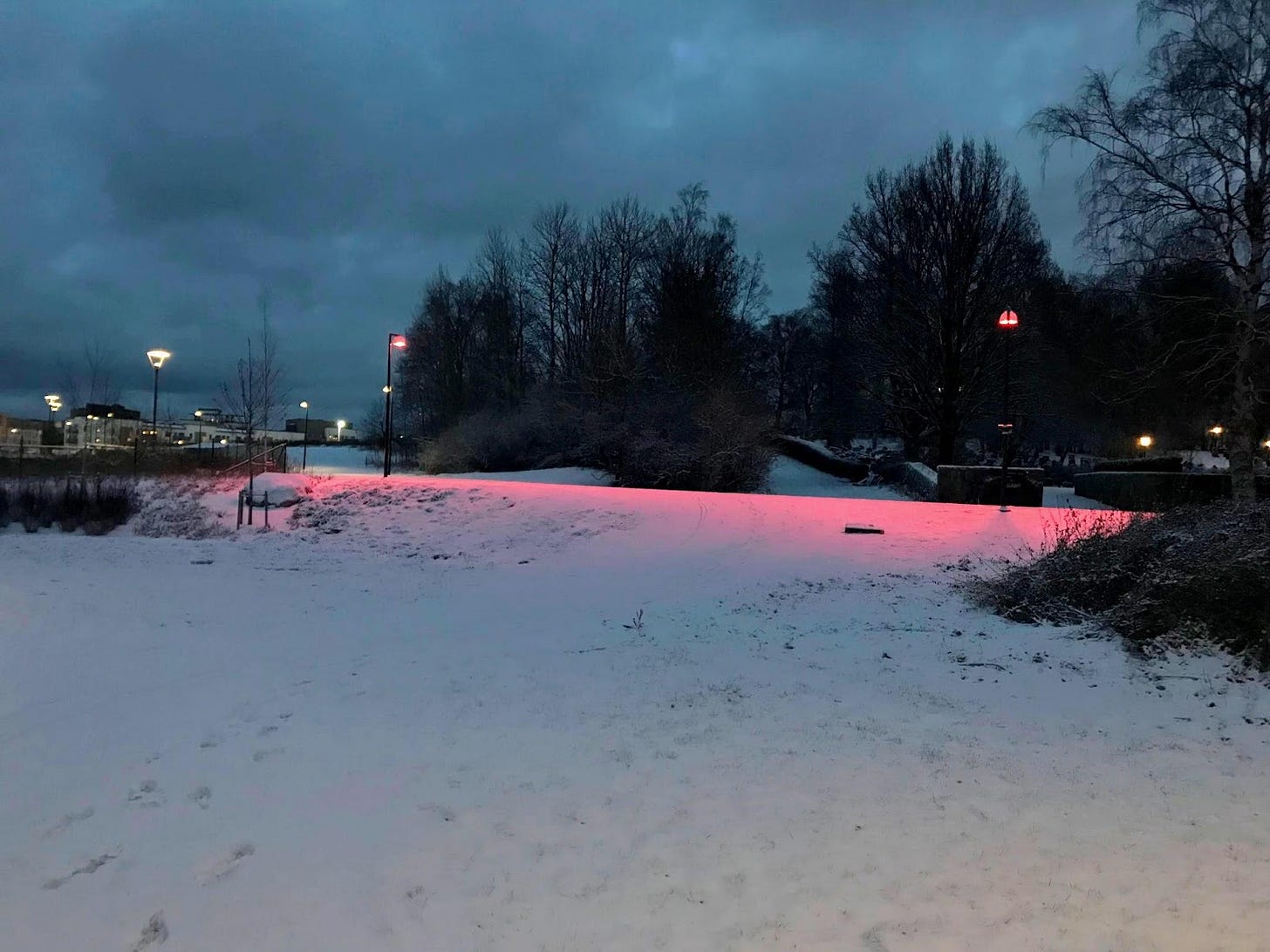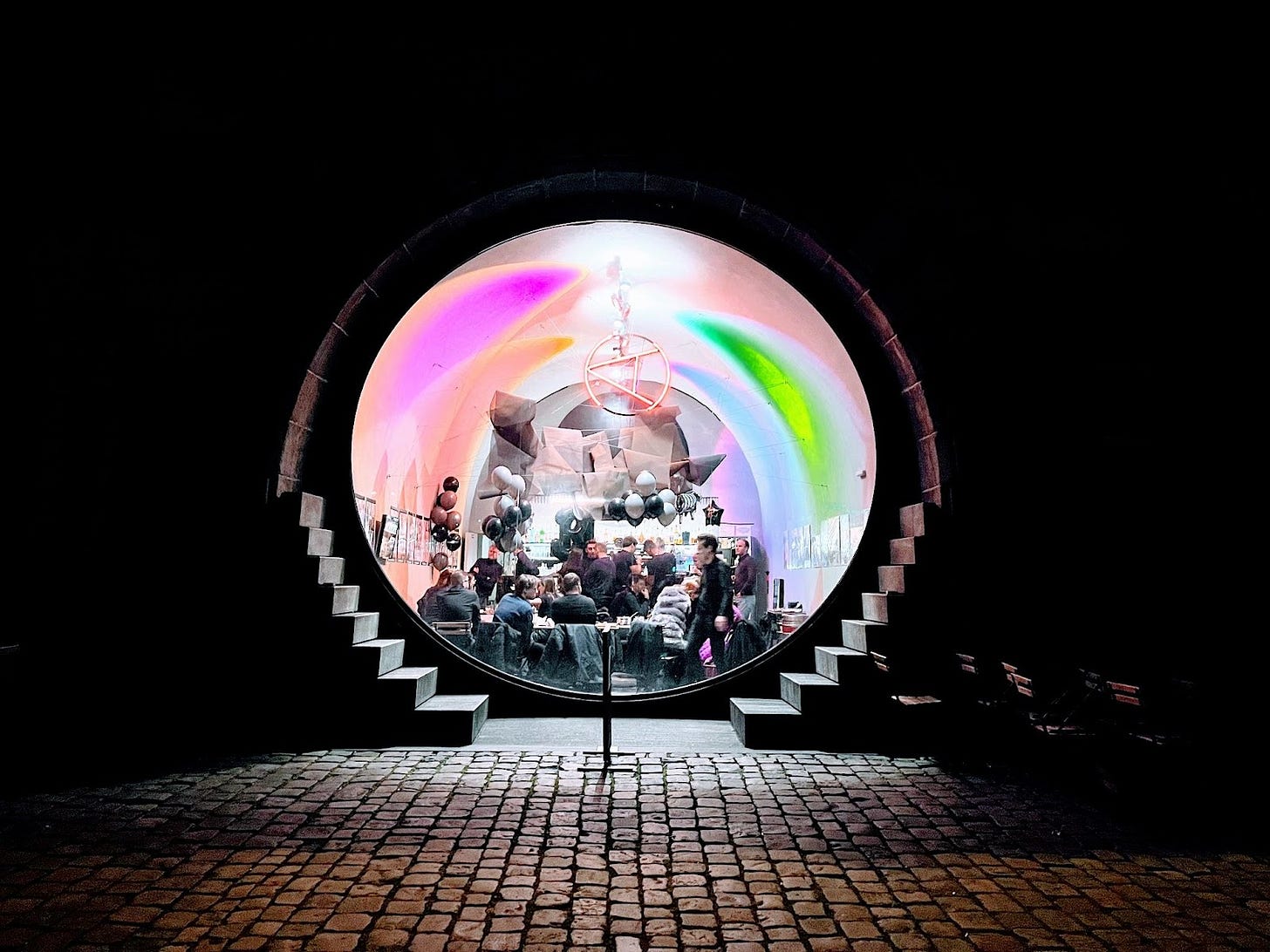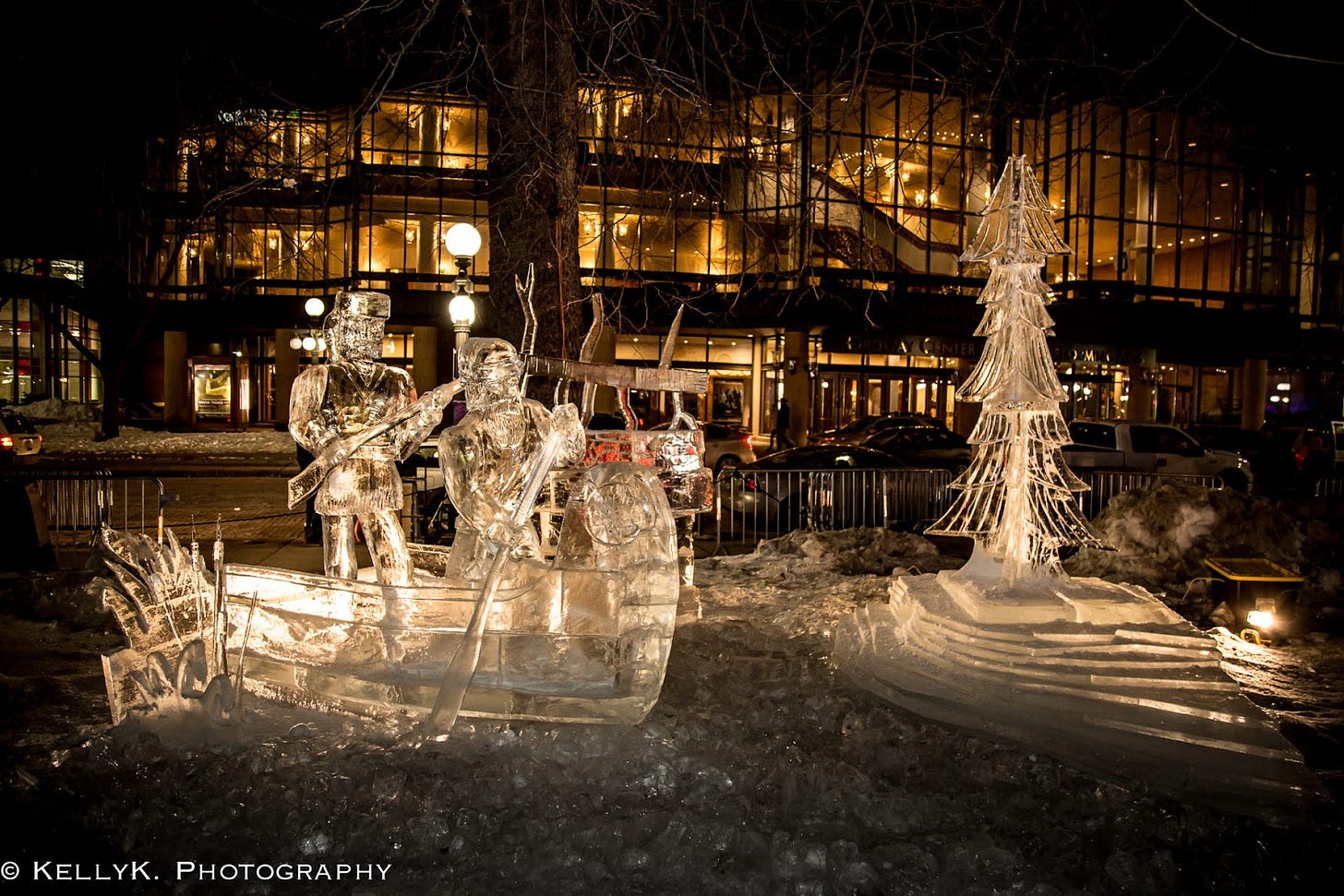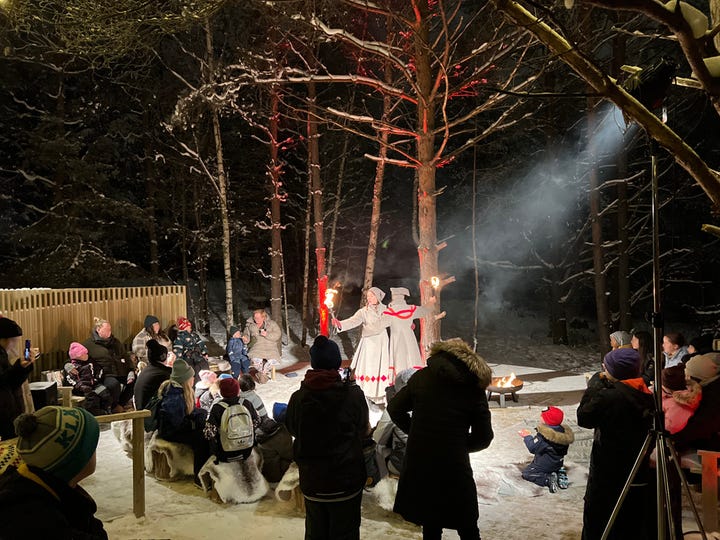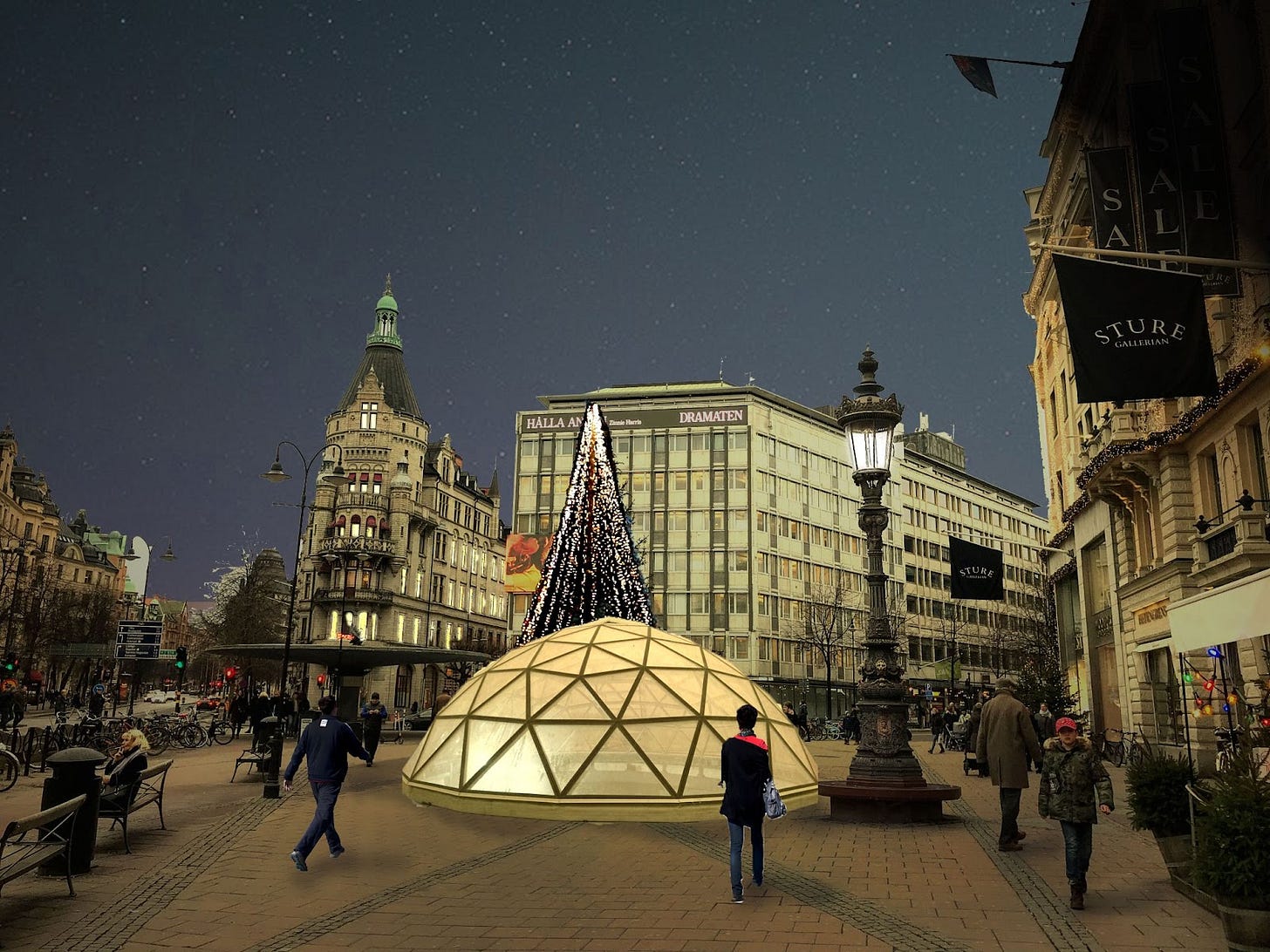Sustainable Winter Cities
Swedish winters are terrible. But in Stockholm, relatively south of Sweden, you don’t get the extreme temperatures you might expect. The worst I experienced was a few days at -25°C.
How is it terrible, then? The problem is that winter never ends. The temperatures below zero can start in November and last until April. This period includes days when the temperature is above zero, meaning you get snow that melts and freezes every few days. I am writing about winter in March. Let’s not kid ourselves here; the spring will not knock on our doors for another two months.
The winters are also very dark. On December 21st, the sun sets around 14:50.
Pitch darkness on Dec 29, 4:15 pm in Stockholm.
Vegetation doesn’t exist. Once the leaves fall in November, every public park will not see vegetation until late April or middle May. Vegetation is quite a problem considering that Stockholm is a green city (or should we call it a gray city for half of the year?).
Dead vegetation in April in Stockholm.
I never considered myself a tree-hugger, but I can become a happy child once I see flowers and green leaves. I walk around until I am exhausted and take pictures of spring. My May in Sweden usually looks like this. I can even enjoy rainy days under 20 degrees in summer, as long as vegetation is there! Bad weather affects most people. Depression and lack of activity are what almost everyone complains about in winter.
The exact location in Sundbyberg - a difference between October and February
The situation seems unbearable and unfixable. The main challenges are slush, rain, darkness, ice, cold and wind. But why is one whining urban designer talking about seasons? Urban design can help with this problem much more than most know. With clever urban design, Stockholm can become attractive even in bad weather, though it won't be as lively and sunny as Barcelona.
Mistakes
Green infrastructure
City parks are dead in wintertime. If there is no vegetation, they look depressing. Some helpful tricks to consider would be to rethink the type of plants we are planting. Plant more evergreen vegetation. Why should the vegetation be dead for half of the year? I believe that this has not been reconsidered due to overwhelming 3D visualizations. Renderings for parks are primarily rendered in summer - early autumn time. If it’s an idyllic winter, it will be filled with snow. Making visualizations as attractive as possible makes sense, but the reality is not always pleasing. I would also make it obligatory to have visualizations for a sad gray day in February. This approach could put another perspective on public space and make designers more creative. More on how architects ‘fake’ reality with visualizations read in my latest post.
Even though I like this part in Årstaberg in Stockholm, there is a massive difference in how the park looks on a sunny visualization - top picture (1) and on a winter day in real life - bottom picture (2).
Maybe a day in Gothenburg like this is our frequent reality in Sweden, and we should consider this visualization more relatable (3)
Winter marketplaces, food, and festivals
In Sweden, the absence of a vibrant food culture is palpable, leaving residents and newcomers yearning for community gathering spots and affordable street food options. Historically, Sweden's harsh conditions and limited ingredients shaped this absence. However, economic shifts and globalization are slightly transforming the culinary landscape.
Today, Sweden's food scene is marked by expensive restaurants and a lack of accessible markets, exacerbating societal segregation. Compared to the bustling winter streets of Central Europe, in Stockholm, you will find Christmas markets active in November, some until the middle of December. If you walk to Gamla Stan on Christmas Day, you will encounter a closed Christmas Market.
Christmas Day in Gamla Stan, 2018
Swedish Christmas Markets can start even in October! But no way they are open during the Christmas and New Year holidays (4)
In Stockholm, enhancing marketplaces to cater to diverse tastes, times, and budgets could bridge social divides and cultivate a more vibrant food culture. More vibrancy also applies to local cafes and generally places that do not serve alcohol. They are rarely open after work hours. Sweden could create public spaces that foster connection and community by prioritizing inclusivity, engaging residents, and embracing diverse working hours.
Pedestrian-friendly infrastructure
Making sidewalks safer and more accessible is crucial for getting around effortlessly. Clean sidewalks simplify walking to places like the store or bus stop without worrying about slipping. Some might not realize how important this is. Think about people with disabilities who rely on clean paths. Everyone, including grandmas with their trolleys, should be able to use the sidewalks without any trouble.
Deathtrap bus station in Sundbyberg. The white tiles become super slippery under a thin layer of snow.
Winter cycling infrastructure
It is not just sidewalks; bike lanes should also be clear of snow so people can cycle safely, even in winter. Imagine being able to ride a bike all year round! Yes, it is possible.
Me coming home from cycling at -13°C
The lack of spontaneity in Swedish culture
This can be attributed to several factors deeply rooted in society’s social norms and values.
Reserved behavior: People tend to be more reserved and formal, preferring structured plans and communication through official channels rather than spontaneous interactions.
Environment: The country's prolonged winters necessitate the efficient use of energy for indoor heating, leading to a preference for indoor activities over outdoor spontaneity.
Given the prevailing circumstances, it is not surprising that people are hesitant to freely interact with others in public squares and engage in spontaneous activities. The combination of various factors appears to be responsible for this phenomenon. However, it is crucial to recognize that social connections are essential for mental and emotional well-being, particularly during the cold and dark seasons.
Winter-friendly public spaces
But it's not just about getting from one place to another. To make streets and squares more inviting, they need to be comfortable places to hang out. Adding things like warmth, light, and protection from the wind can make a big difference in how people feel about spending time outside. Still, things have to be connected to exciting spots and events, so people have a few attractive options while outside.
What other activities are expected here aside from smoking? Blåsut metro station, Stockholm
What makes a great place? It should be inclusive, comfortable, versatile, and visually appealing. PPS developed the diagram below to help people judge various places. The more checkboxes a place ticks, the more successful it will be.
Good public space (Pps.org, 2019) (5)
The average speed of pedestrians on Strøget Street in Copenhagen (Gehl, Svarre 2013) (6)
The graph shows that people tend to walk slower as summer gets closer. When it's warmer and brighter outside in Scandinavia, people like to relax and enjoy outdoor activities, so they take their time. In Stockholm, the weather is usually cold, and walking in summer to catch some sun rays and enjoy the weather is a big contrast, so a graph from Copenhagen can relate to Stockholm. The main challenge remains pushing people outside to socialize in the winter months.
Swedish Love for Nature
Nevertheless, despite the preference for indoor activities, Swedes maintain a strong bond with the natural world. Activities such as hiking, skiing, and camping underscore their inherent appreciation for spending time outdoors. This love for nature can foster spontaneous outdoor ventures and exploration. It contributes to a culture that embraces spontaneity alongside formalities. Can we facilitate this behavior and use it in more urban public spaces?
Mixed-use development
The type of urban development can help with that. What is mixed-use development? Over time, urban planners have learned that blending residential, commercial, and communal spaces creates more vibrant and efficient neighborhoods. This approach has been around since the beginning of civilization. Its goal is to improve people's lives by reducing traffic, adding vitality, ensuring safer roads, boosting economic well-being, and encouraging environmental consciousness within communities. Designing neighborhoods using this method makes it easier to combat our winter challenges. Mixed-use development creates a more vibrant environment without too much effort.
Sundbybergs Centrum in Stockholm is an excellent example of shops and restaurants on the ground floor with apartments upstairs that make a mixed-use neighborhood.
Little shops and a pedestrian street. Hökarängen is another example of a lovely neighborhood in Stockholm. (7)
However, Stockholm is still far behind; not all new urban areas are designed with mixed-use development. Many neighborhoods in Stockholm are designed only for sleeping. They have a metro station, a small and expensive grocery store, and a below-average-quality kebab pizza place. There might be a below-average-quality Asian confusion restaurant, too. However, such neighborhoods cannot offer more than a place to sleep. People are likelier to take the metro to the city center for a broader range of amenities.
How is it possible to have less traffic in dense urban environments? Increasing density leads to a decrease in traffic congestion. When people live closer to the amenities they want and need to access, there is less reason to drive or even own a car. So, if you love driving and hate traffic, you should be an advocate for increased density. The more people can walk, bike, or take public transportation to meet their daily needs, the more road you will have to yourself. (8)
Transit-oriented design
This design works well with mixed-use buildings. It's crucial to clear bus and train routes quickly when snow comes. Reliable public transport makes people more likely to want to go out, especially for fun winter activities. But they need to know they can rely on public transportation even when it's snowy. Public transit should also be cheap, especially compared to driving a car. It would be helpful if there were a limit on how much you have to pay for monthly bus and train rides. This way, you could travel more spontaneously without worrying about the cost of transportation. You wouldn't need a monthly card to benefit from this limit.
Pendeltåg commuters in Stockholm can probably count on their fingers how often the train came on time in the last year. (9) People are less eager to commute if the system doesn’t work.
Cities around the world are fighting winter
Cities worldwide have been working on cool projects to get people outside and having fun during winter. They're making special places just for winter activities. These projects are all about making winter more fun and exciting for everyone who lives in the city or comes to visit. Let's check out a few ways cities have made winter more awesome:
Ice Skating Rinks
Being comfortable outdoors in the winter often means being physically active. Many cities create temporary ice skating rinks in public squares or parks. These rinks serve as a fun and active way for people to enjoy the winter season together. They often feature events and activities such as skating lessons, ice sculpting, and even holiday markets. In Sweden, the lakes sometimes get so frozen that walking or doing sports is safe. Ice skating events can be organized and promoted at a low cost.
Rastasjön lake in Solna, Sweden
Winter Sports and Activities
Cities often host winter sports events such as snowboarding, skiing, and ice hockey tournaments. These events attract participants around the city and can be a great way to engage the community and promote physical activity during winter.
Snow Parks
Some cities designate areas as snow parks, where people can build snow forts, sled down hills, and enjoy snowball fights. These parks often have snowmaking machines to ensure a steady supply of snow. (10)
Winter Festivals
Cities worldwide host winter festivals that celebrate the season with food trucks, live music, and activities. These festivals are a great way to unite the community and make the most of the cold weather. Innovative urban planning and cultural events like Budapest and Zagreb's Christmas Market can revitalize city spaces, promoting inclusivity and economic growth.
Christmas Market in Zagreb, Croatia
Illuminated Paths and Light Installations
In winter, cities light up paths, parks, and public places with colorful lights to make them less dark and gloomy. Creative lighting makes cities look like magical winter wonderlands and encourages people to go outside and have fun.
A pathway lit on a Christmas Market in Zagreb, Croatia
Moose near Kungsträgården in Stockholm
Entrance to the Old Town in Tallinn, Estonia
Light show event in Stockholm
7:47 am on December 2021 biking to work. This silly, lightened pink bike path helped me feel less depressed and safer. Barkarby, Stockholm
This unique circle functions as a space inside while piquing the curiosity of passers-by and illuminating the exterior. Located in Prague, Czechia. (11)
Snow Sculptures and Art Installations
Cities often hire artists to create snow sculptures and winter-themed art in public spaces. Winter art adds to the city's visual appeal and provides a talking point for tourists and locals.
Ice competition in Saint Paul, Minnesota
Winter Haven
In Bro, a town north of Stockholm, a new project called Winter Haven has been created to give people more things to do all year. The municipality worked with locals to ensure everyone could enjoy it, no matter how old they were or how much money they had. They wanted to make Bro a fun place for everyone in the winter, with activities and places to hang out.
They started the project in 2022 by asking people in the area for ideas. People wanted things like obstacle courses for kids, spots to play, places for older folks to meet up, and areas for cultural events.
Winter Haven is a fantastic outdoor spot with benches for parents, places to grill food, sheltering from the wind, play areas, and stages for events. They also built ramps to make it easy for people with disabilities to get around. (12)
Winter Haven, Upplands-Bro municipality, Stockholm (12)
Money is not always the answer to have fun
The point of public space is that it is for everyone, and it should be possible to have a few activities outside in the winter that you don’t need to pay for!
A pavilion my master’s group planned with free activities such as multidisciplinary workshops and tourist information on Stureplan, Stockholm (13)
These examples demonstrate the creative and innovative approaches cities worldwide take to make winter more enjoyable and active. By transforming their urban spaces into winter wonderlands, cities encourage residents and visitors to spend more time outdoors, fostering a sense of community and appreciation for the season.
Room for improvement
Swedish winters can be tough, with darkness, cold, and little greenery. But we can make them better by coming up with new city designs and getting everyone involved. Things like making it easier to walk around, having bike paths that work in winter, and creating nice places for people to hang out outside can help.
We can also be more spontaneous and enjoy nature, like having fun in winter markets, cool festivals, and lighting up paths so people feel safe walking around. Looking at what other cities do well and adapting those ideas to fit Stockholm or another city can also make a big difference.
Are you tired of boring winter public spaces? Or have you stumbled upon an amazing one that you want to share with the world? Snap some pictures and send them my way! I'd love to showcase the best (and worst) winter spots on Instagram and TikTok. Let's spread some inspiration and make the most out of this chilly season!
Årstabergsparken del 1 – Rävskogen, Stockholms stad. Available at: https://vaxer.stockholm/projekt/liljeholmen/arstabergsparken-del-1-ravskogen/ (Accessed: 18 March 2024).
Roven, H. (2021) Årstabergsparken - höga kanor, parkour och utkikstorn, Familjeparker.se. Available at: https://familjeparker.se/lekparker/arstabergsparken-hoga-kanor-parkour-och-utkikstorn/
Normkreativ visualisering i stadsutveckling - FoU: White Arkitekter (2023) White Arkitekter Sverige. Available at: https://whitearkitekter.com/se/forskning-utveckling/normkreativ-visualisering-i-stadsutveckling/#:~:text=Normer%20och%20v%C3%A4rderingar%20styr%20hur,arbetsprocesser%20inom%20arkitektur%20och%20stadsutveckling.
Redaktionen, L. (2023) Här är de 15 mysigaste julmarknaderna i Sverige, Leva & bo. Expressen. Available at: https://www.expressen.se/leva-och-bo/jul/julmarknader-2023-har-ar-basta-julmarknaderna-i-sverige/
What Makes a Successful Place?, RSS. Available at: https://www.pps.org/article/grplacefeat (Accessed: 3 March 2024).
Gehl, J. and Svarre, B., 2013. Public Life Studies in Practice. How To Study Public Life, pp.123–148. Available at: http://dx.doi.org/10.5822/978-1-61091-525-0_6
Juliayoda, A. (2014) Mysigt i Hökarängen, Julia Anna Yoda. Available at: https://juliayoda.wordpress.com/2014/01/23/mysigt-i-hokarangen/
Siegler, J. (2024) An Irrational Fear of Density, LinkedIn. Available at: https://www.linkedin.com/pulse/irrational-fear-density-jeff-siegler-sxwne/
Alm, S. C. (2023) Pendeltåg inställda: Så kan du tackla kaoset, RSS. TV4 Nyheterna. Available at: https://www.tv4.se/artikel/71P9LLEw8La6eFc1vhR0Vq/sl-det-haer-gaeller-om-du-drabbas-av-pendelkaoset
GETTING A SNOWPARK IN YOUR CITY WITH CONCEPTIONS SNOTECH (no date) Empire Online Store. Available at: https://thinkempire.com/blogs/news/getting-a-snowpark-in-your-city-with-conception-snotech (Accessed: 17 March 2024).
Insidecor, www. insidecor. cz, Pražská náplavka díky architektovi Petru Jandovi ožila, Insidecor. Available at: https://www.insidecor.cz/blog/prazska-naplavka-diky-architektovi-petru-jandovi-ozila/ (Accessed: 18 March 2024).
Vinterrum. Available at: https://www.upplands-bro.se/upplands-bro-utvecklas/utvecklingsprojekt/omdaning-bro/vinterrum.html (Accessed: 17 March 2024).
Advanced Urbanism Studio, KTH: Sven Lindenmann, Divya R.V., Irena Toljan, 2018




